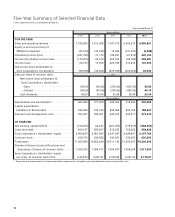Sony 2013 Annual Report Download - page 52
Download and view the complete annual report
Please find page 52 of the 2013 Sony annual report below. You can navigate through the pages in the report by either clicking on the pages listed below, or by using the keyword search tool below to find specific information within the annual report.
(FY)
Greenhouse gas emissions from energy consumption
Emissions of PFCs and other greenhouse gases
(calculated in terms of CO2)
2.22
2000 2010 2015
Target
1.53
2011
1.50 1.55
2012
1.26
Greenhouse Gas Emissions
from Sites
(Millions of tons of CO2)
Environmental Activities within Sony’s Operations
Curbing Climate Change
Reducing greenhouse gas emissions at sites
In fiscal year 2012,
greenhouse gas emis-
sions at Sony Group
sites were approxi-
mately 1.26 million tons,
down approximately
43% from fiscal year
2000. To reduce green-
house gas emissions,
Sony has prioritized the
ecient use of energy
at its sites. Of particular
note, in recent years
Sony has expanded
its focus beyond the
upgrading of buildings and equipment for better
eciency to also include operational and manufacturing
processes aimed at achieving improvements from the
bottom up. Best practices are swiftly implemented at
Sony Group sites worldwide.
Sony is also aggressively pursuing the use of renewable
energy. In fiscal year 2012, Sony succeeded in osetting
global greenhouse gas emissions by 67,000 tons through
the use of renewable electricity certificates and other
initiatives. Electricity acquired from renewable sources
accounted for approximately 7% of Sony’s total electricity
usage worldwide. Further, with regard to perfluorocarbons
(PFCs) and other greenhouse gases emitted in the
production of semiconductors, Sony is working to reduce
emissions through the introduction of treatment equip-
ment that traps such gases.
Conserving Resources
Reducing waste at sites
In fiscal year 2012, total
waste generated by Sony
Group sites amounted to
approximately 85 thou-
sand tons, a reduction
of approximately 70%
from fiscal year 2000. The
Sony Group’s total recy-
cling rate was 94%. Sony
continues to promote
the reuse and recycling
of site waste in its products and packaging materials on
a global basis.
Conserving Resources
Reducing water consumption at sites
In fiscal year 2012, Sony
Group sites used approxi-
mately 12 million m3 of
water during its opera-
tions, comprising water
purchased or drawn from
groundwater. This was
a reduction of approxi-
mately 55% compared
with fiscal year 2000.
Sony is taking steps to
reduce water used by its sites around the world.
Managing Use of Chemical Substances
Management of chemical substances at sites
Sony has developed
Group-wide standards
with respect to the man-
agement of chemical
substances used at sites
and has implemented
measures aimed at reduc-
ing the amounts of such
substances transferred
and released into the air
and water as emissions,
discharge or waste. In
fiscal year 2012, emissions of volatile organic compounds
(VOCs) released into the atmosphere amounted to
approximately 875 tons, a 52% reduction from the
fiscal year 2000 level. Sony has also established internal
standards for the prevention of environmental accidents,
as well as for emergency responses, as part of its eorts to
ensure the proper management of chemical substances.
Conserving Biodiversity
Measures to conserve biodiversity
Under policies and guidelines related to biodiversity, Sony
is promoting ongoing activities to incorporate more green
spaces at its various facilities and to preserve and restore
the natural environment in the local communities. For
example, as part of a program implemented by Sony Group
companies in Singapore in line with the United Nations’
“Water for Life” Decade, employees of Sony Electronics
Asia Pacific Pte Ltd. together with a local school built 10
floating wetlands for installation at a local reservoir with
the aim to improve water quality and biodiversity in the
area. In the United States, Sony Pictures Entertainment Inc.
launched a website inspired by the 2013 movie After Earth.
The website provides cutting-edge scientific information
and materials for educators pertaining to biodiversity and
other environmental issues.
(FY)
276
128
85
138
2000 2010 2015
Target
2012
116
2011
Waste at Sites
(Thousands of tons)
(FY)
1,836
1,184 1,193
918
2000 2010 2015
Target
2011
895
2012
Release of VOCs into the
Atmosphere
(Tons)
(FY)
27
16 17
12
19
2000 2010 2015
Target
20122011
Water Consumption at Sites
(Millions of m3)
50
























